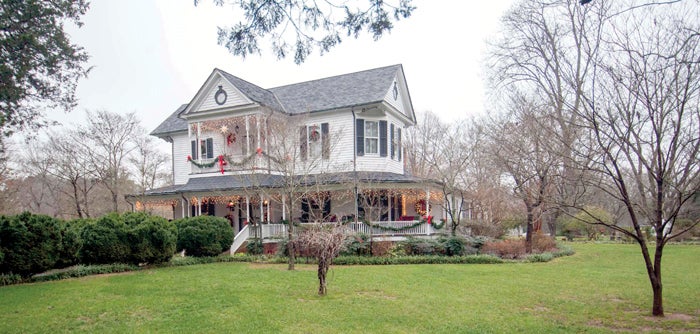Grubb-Sigmon-Weisiger House gets local landmark status on second try
Published 12:02 am Thursday, March 5, 2020

- JON C. LAKEY/SALISBURY POST FILE PHOTO The home of Roy and Norman Campbell at 213 S. McCoy Road was granted a local historic landmark designation. Salisbury,North Carolina,12/22/15.
By Liz Moomey
liz.moomey@salisburypost.com
SALISBURY — After tabling a decision to declare the Grubb-Sigmon-Weisiger House a local historic landmark, the city council returned Tuesday with an approval and a declaration to adapt an ordinance around landmark statuses.
The designation symbolizes the landmark has historical integrity and special significance. And the designation of the 1911 Queen Anne farm house, located at 213 S. McCoy Road, grants a tax credit of 50%.
Applicant Karen C. Lilly-Bowyer and owners Roy and Norma Campbell began the landmark application in April 2018 with the Historic Preservation Commission. The State Historic Preservation Office reviewed the Grubb-Sigmon-Weisiger House application and returned their comments to the commission to the state in January. The commission recommended the property to be designated in February.
The house’s portions were built in 1911, 1927 and 1942.
Lilly-Bowyer said one of the owners, Ross Ninish Sigmon, was the developer of the Milford Hills area. Henry Clay Grubb was another owner of the home. He was was the owner of one of Salisbury’s largest distilleries, was tried for the murder of his brother-in-law and built what was the tallest steel structure building in North Carolina at the time, The Plaza. Grubb later was murdered by his wife. Leslie Marshall Weisiger was the third owner the house was named after.
At a Feb. 18 council meeting, Mayor Karen Alexander and Councilman David Post were not in favor of the designation.
Alexander cited her concerns about the 50% tax credit and the lack of policy about what makes a property significant or not. A tied vote, with the absence of Councilman Brian Miller, would have failed the designation. So, the council tabled the decision.
During its second consideration, several citizens spoke in favor of the designation, including Lilly-Bowyer.
“If the council is looking for the best of the best in historical architectural integrity and significance, you need to look no further than the Grubb-Sigmon-Weisiger House,” Lilly-Bowyer said.
Historic Salisbury Foundation trustee Michael Young said there are examples of Victorian Queen Anne homes in Salisbury and Rowan County that are contributing structures to places listed in the National Register of Historic Districts, but that doesn’t make them landmark worthy.
“It is the house and who lived in the house and their contribution to the development, heritage and cultural characteristics of the City of Salisbury that makes it exceptional,” Young said. “And this house is exceptional.”
Jacquelyn Jensen, chair of Historic Preservation Commission in Spencer, said newcomers and residents are attracted to Salisbury because of its investment in historical places. A tax credit can help owners with the cost of maintaining historical properties, she said.
“Finances can be quite complex when managing renovating historic properties,” Jensen said. “Tax credits available to landmarks allows owners to offset some of their cost and mindfully execute their project to the upmost care to preserving its history.”
Councilwoman Tamara Sheffield responded to Alexander’s concerns about the city’s budget if they approve the designation.
The City of Salisbury property tax of the house for 2019 was $2,378.
“In the big grand scheme of things, we’re really only talking about $1,200 here folks,” Sheffield said. “If you have an old house, it’s going to take a heck of a lot more to take care of that.”
She continued to say she didn’t think it was fair to keep the family in flux because the city didn’t have a policy.
Miller said he thought the house was historically significant and his issue wasn’t the home or the application.
“It is an unique property,” Miller said. “What I’m in my mind trying to figure out is there are a bunch of properties in Salisbury that have historical significance because of the way we preserve things. Is it better to go after them one at a time and do landmark status or is it better to catch them in neighborhoods as groups?”
Mayor Pro Tem Al Heggins said she understood Miller’s perspective but had concerns about historical properties that weren’t in historical areas.
“I just don’t want us to cut off our noses to spite our face because we make it so tight that we begin to leave out significant buildings in our community that have importance, and we don’t protect them because they don’t happen to be sitting in a historical section,” Heggins said.
Alexander said the policy for landmark designation is “woefully inadequate.”
The council unanimously approved the designation. The Grubb-Sigmon-Weisiger House joins three other landmarks, the Temple House, at 1604 Statesville Blvd., the Empire Hotel, at 212-228 S. Main St., and the Salisbury Southern Railroad Passenger Depot, 214 Depot St.
The council also agreed to a moratorium as they worked on fixing the ordinance before other local historic landmark designation requests come before them.


